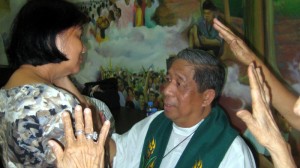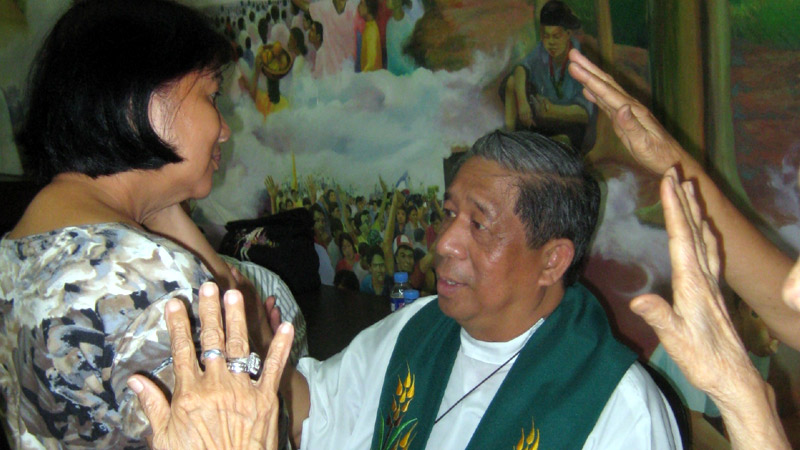
At three o’clock in the morning, while the world sleeps, troubled souls rouse this priest to relay important messages or confess their sins so they can move on gently and finally to eternity. The otherworldly messengers include Navy officer Phillip Pestaño who came back to tell the world that his death was not a suicide as some officials would have us believe. Another group of souls gathered by the priest’s bedside and told him they were victims of the 2009 Maguindanao massacre.
The apparitions initially puzzled Fr. Efren Borromeo of the Society of Our Lady of the Trinity (SOLT). Affectionately called Fr. Momoy by Bicol folk, he thought it was just one of those things. “I was reluctant to recognize it,” he says. “I know saints have soul visitations, but I am not a saint!”
Ghostbuster, spirit questor or saint, the label doesn’t matter. People whose lives he has touched agree that Fr. Momoy has the gift of healing the sick and seeing souls. He also has the ability to see through human bodies and reveal with uncanny accuracy what ails those who consult him, just like the radiology method called MRI or magnetic resonance imaging.
Though not a medical doctor, Fr. Momoy has basic knowledge of the human anatomy and is in fact, on his way to becoming another kind of doctor. He is finishing his dissertation for a doctorate degree in cosmic anthropology at the Asian Social Institute in Manila.
His cosmic encounters do not scare him, Fr. Momoy confides. In fact, he considers them a nuisance. “I would ask, why do you have to come for confession? Why don’t you go direct to heaven? Nakakaistorbo kayo (You guys are a bother).” But the souls continue to turn up at all hours of day and night. “That’s why I can’t drive,” he says. “I see dead people.”
One group he couldn’t just ignore because of their sheer number showed up in the dead of night. “Who are you, why are you so many?” he had asked. They were, the apparitions answered, the victims of the Maguindanao massacre. (In that November 2009 tragedy, 58 people, most of them media practitioners were brutally killed and buried in shallow graves. The main suspects, the members of the Ampatuan political clan, are now in jail and on trial.)
“I was very tired then so I told them to go, and instead visit the one who had them killed,” Fr. Momoy recalls. “A few days later, I read that one of the alleged perpetrators of that massacre was reportedly being haunted and was asking for a change of room.” He laughs at it now.
Some years ago when the TV game show “Deal or No Deal” was running, Fr. Momoy realized that he could see the contents of the attaché cases that participants were to choose from. For seven nights he followed the show and saw which case had the plum prize in millions. Why didn’t he join then? “That would have been unfair advantage,” he says. “And I might lose my gift.”
Was the gift always there? How did he even know he has it?
“I was born a breech baby,” the 60-year-old priest says. “Those born feet first are believed to have the ability to dislodge fish bones stuck in people’s throats.” The boy Momoy was always called upon for such cases. His grandmother was a hilot or practitioner of indigenous healing. When a locust infestation hit their town in Albay, he was asked to try driving the pests away and he did. There was something about the boy, his father had said.
The youngest of five sons of the late Ernesto Borromeo and Felicitas Bragais, now 93, Momoy was born in Ligao, Albay. “We were not well-off so on weekends I would sell candies and newspapers,” he narrates. “I was sickly and would sometimes be in hospital. My uncle, a doctor, had syringes that I would play with. At home, I would inject the dogs and cats. I had invisible playmates.”
It was not until he had grown in age and grace that his special abilities became more evident.
Fr. Momoy vividly recalls that in 1966, on the Feast of the Sacred Heart, something happened that would change his life. A deranged man stabbed to death Fr. Jose Guerrero, the parish priest in Ligao town, while he was visiting the sick in a hospital. “When I heard the pealing of church bells, I just knew he was dead. There was thunder and lightning. I was devastated.”
At a church meeting held after the burial, parish officials stressed that the town would have to replace the dead priest with one of their own to offset a curse. “Ligao at that time had not produced a priest of its own for 16 years,” Fr. Momoy says. He decided it was going to be him.
He reflects: “Hindsight shows that my fiat, though tainted by misplaced guilt, opened doors to mystery. Almost immediately I experienced a lifting of my serial illnesses. If Saul had to be stricken off his horse to be transformed, I had to be drawn to my own calling by the village in need of a substitute offering – not a scapegoat, I hope!”
His motive may not have been the purest in the beginning. “I saw it as an opportunity to study. In our family, I was the only one who finished college. When my parents objected, I said, it’s the seminaryo or the sementeryo.” Off Momoy went to the St. Gregory Minor Seminary in Legazpi City in Albay, and later, the Holy Rosary Major Seminary in Naga City.
“I was never really sure of my priestly vocation,” Fr. Momoy muses. “In college at the Divine Word University, I was drawn into political activism. After finishing AB Philosophy, I took a leave to think things over.”
While doing his summer apostolate, the seminarian met Fr. Thomas Gier of the SOLT congregation. “I came, I saw and was conquered,” he says. He was a step away from ordination when he proceeded to the SOLT novitiate in Albuquerque in New Mexico in the US. In 1979 Fr. Momoy was ordained by Bishop Teotimo Pacis at the St. Stephen’s Church in Ligao.
Fr. Momoy ministered to the ailing during his brief stay in his congregation’s hospice for AIDS patients in Bangkok. Later, as a parish priest in a remote island in Bicol where there were no doctors, he ministered to the sick. “I carried around a priest’s sick call kit that also contained a stethoscope and other medical paraphernalia. I had even assisted a woman in labor.”
He discovered the wonder of coconut water and made a sugar-salt-water solution for dehydrated patients. Holy water and oil were for the sacraments. In fact, he muses, it was when he was administering the sacraments that his gift of healing slowly came to the fore. And through all these, he says, “I also realized in a special way na pari pala ako (that I was a priest).”
But he had yet to see something dramatic happen before his eyes.
“Once I was called to go to a communist-occupied mountain area. When I arrived, the men who were making a coffin said that I had come too late. I went to the dying man and anointed him. I saw many people surrounding him. After I was done, I saw only three people standing.” The rest who had vanished turned out to be souls. The man died. Or so everybody thought. Recounts Fr. Momoy: “I was about 100 meters away when I heard a commotion. The dead man had come back to life! He is still alive today.” (A TV crew tracked the man down not too long ago.)
Fr. Momoy had his own near-death experience. In 1994, while traveling from Manila to Bicol, pranksters threw stones at the vehicle he was in. “I was hit on the right eyebrow. I felt pain. This was followed by an indescribable feeling. Then I saw myself outside the car looking at my bloody self. I asked, is this it Lord? It’s up to you.”
His companions cried, “Si Mamo, wala nang pulso [Mamo has no pulse]!” After about seven minutes in that blissful state, Fr. Momoy’s spirit reunited with his body. “I was so angry with God for bringing me back.” Another strange thing happened immediately after: He found himself in a doctor’s house that had no signage on it and without anyone giving him directions.
After this episode, Fr. Momoy’s “20-20 vision” of internal organs became sharper. It also erased his self-doubt. “At first I thought seeing souls were just part of being a priest,” he says. He even went to Fr. Jaime Bulatao, SJ, a well-known clinical psychologist and expert on the paranormal, for affirmation, and consulted with two bishops and some friends who assured him that he was sane.
Since then Fr. Momoy has been meeting the souls of dead priests, bishops and ordinary folk, some of whom he doesn’t know. The communication is not verbal. He says, “God’s hand is not shortened by death and (continues to) reach souls in need of forgiveness. His mercy is indeed forever.”
One case that helped affirm Fr. Momoy’s gift of seeing was that of Navy officer Phillip Pestaño who died in 1995 under mysterious circumstances. Military officials ruled out foul play and said it was a suicide but Pestaño’s family believed otherwise. Lawyer Felipe Pestaño, Phillip’s father writes: “A priest, a complete stranger out of nowhere, came to see us at Phillip’s wake. Accompanied by a nun who was a distant relative, he revealed that Phillip had asked him to convey a message: ’Tell my parents I did not commit suicide.’”
Fr. Momoy told the Pestaños that for the first time, someone from the other life was asking him to do something. Phillip had appeared to the priest three times. In his written account, Phillip’s father says he was incredulous even though the priest described in detail how his son was killed. It was when Fr. Momoy described Phillip’s character and personality – without having met him at all – that the older Pestaño finally believed him.
Three years later, at a Senate hearing, a forensic expert who had done work on the O.J. Simpson case gave his own description of how Phillip was murdered. It matched Fr. Momoy’s account. According to Phillip’s father, the Senate ruled that the murder was not committed by just one man.
Fr. Momoy reflects: “Are my ’spirit guests’ on a mission on their own to prod me to minister to their grieving kin for whom the other life is totally disincarnate? Let me now continue viewing these spirit guests without a fearful ego.”
Fast forward to the present. Fr. Momoy presides at the Trinitas Integrative Healing Ministry Center under the SOLT in Bonga, Albay. He also does “hospice work” by visiting the sick and the dying in their homes.
Many have experienced healing, among them, Helen Alvarez who at 92 was diagnosed to have Alzheimer’s. Distressed, her daughter Mila A. Magno, asked Fr. Momoy to regularly pray over her mother. He was the family’s house guest in Canada. One day, to everyone’s surprise and joy, Helen emerged from the mist, regained her memory and was again her usual happy self. “Mama lived five more happy and productive years with us before she succumbed to congestive heart failure,” Mila attests. “Up until her death at 97, she remembered everyone by name.”
Although Fr. Momoy does not accept payment, he welcomes donations for the maintenance of the healing center in Albay and his ministry for the poor. He adds sheepishly, “Manay Mila (Magno) gave me an iPad.”
In conducting healing sessions, Fr. Momoy would rather not wade into crowds. He prefers small groups so that he can attend to every individual in a special way. He asks a group of 10 to come forward and scans each patient with his “MRI eye.” He verbalizes what he sees while the rest lay their hands on the patient and pray. Those waiting for their turn are led in prayer and reflection by volunteers and those who have experienced healing.
“This is also a time for evangelization,” says Sr. Sonia Punzalan of the Religious of the Cenacle. A certified teacher of zen meditation, Sr. Sonia is convinced of Fr. Momoy’s gifts and regularly assists him. “Sickness and death offer spaces for finding God in all things, and seeing the world as charged with grandeur! I reiterate Fr. Momoy’s basic orientation: ’There is no space without God.’ As certified Zen teacher of Sanbo Kyodan school, Kamakura, he presents with power the koan: ’Medicine and disease cure each other.’”
Because of his academic background, Fr. Momoy is able to explain the healing phenomenon and articulate it in anthropological, biblical and spiritual terms. His doctoral dissertation is a treasure trove of “eidetic” insights. The priest encourages the “healees” to write down their experiences and reflections so that others may learn from them.
The testimonies, he says, “have challenged my incredulity and made me conscious of my own biases and theological baggage. Gradually, I learned to approach patients, their faith rubbing off on me, not in my own terms but in theirs – their dreams, fears, pains and joys. The shift to the inner realm of the heart is like treading holy ground, and there’s no other way but to go unshod.”
Amazed at his gifts, some noted persons in both the academic and spiritual fields have closely examined Fr. Momoy’s ministry. Zen practitioner Ricardo Gonzalez writes that the healing in Trinitas “is actually (a) quantum mechanics phenomenon.” This means that changes occur via the observer effect, “where a thought is believed to carry an energy force that can influence events and conditions within the physical world.”
Himself a zen practitioner, Fr. Momoy spends an hour in zazen or what he calls in Filipino, pahingalay before healing sessions. He also asks the people to pray over him. “Again, moments before the actual healing, I go into silence, somewhat like a moment of egolessness.” In this state, he says, “There is no longer a separation between healee and myself. For sweeping over me is not just the patient’s pain but also his doubts, resentments and fears. I am so soaked in the experience of oneness such that inner/outer, psycho-emotional/physical separation is non-existent. Then, in an instant, I snap out of that realm and go on with the healing session.
“As the next patient steps forward and whispers his or her health concern, I am brought to a state where words cease to stay on a verbal thinking level. The person becomes a dynamic trigger for images of ailing cells, tissues, organs and systems.”
Dubbed a “Christian Babaylan” by the Baylans of Maramag, Bukidnon, Fr. Momoy says the indigenous rite he went through with them seemed “to open doors that made it possible for me to flow easily through different levels of consciousness. Based on co-gnosis – seeing directly the ailing organs without having to rely on lab reports – whenever the gift floods me, without hesitation, I can now confidently describe the behavior, size, color of tissues and organs. On occasion, the medical doctor assisting me pushes in my hand anatomy charts. I leaf through the pictures and point to the organ in question.”
Fr. Momoy enthuses, “It is with awe and gratitude that I feel the grounding effect of this spirituality shrouded in mystery of grace upon grace. Einstein’s famous words echo in my heart: ‘The most beautiful thing we can experience is the Mysterious. It is the source of all true science.’” •
Fr. Efren Borromeo holds healing sessions at UP Delaney Hall on Monday mornings when he is in Manila. The Trinitas Healing Center is in Bonga, Albay.









































